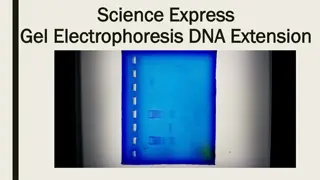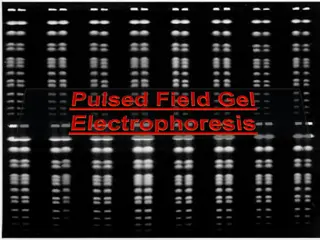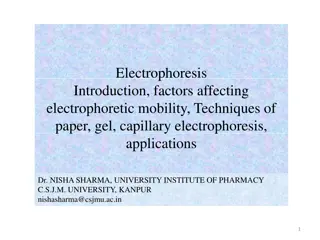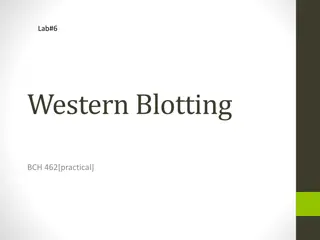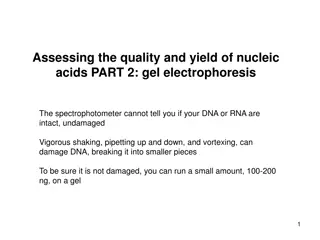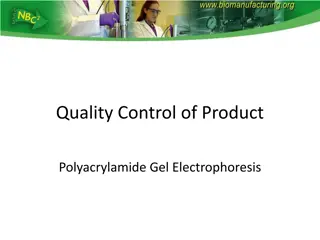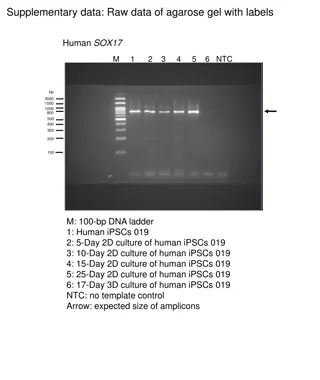
SDS-Polyacrylamide Gel Electrophoresis in Biochemistry
Learn about SDS-Polyacrylamide Gel Electrophoresis, a technique used to separate proteins based on their molecular weight. Understand the principle behind SDS-PAGE, the role of SDS, and the formation of polyacrylamide gel for protein separation in biochemistry and molecular biology.
Download Presentation

Please find below an Image/Link to download the presentation.
The content on the website is provided AS IS for your information and personal use only. It may not be sold, licensed, or shared on other websites without obtaining consent from the author. If you encounter any issues during the download, it is possible that the publisher has removed the file from their server.
You are allowed to download the files provided on this website for personal or commercial use, subject to the condition that they are used lawfully. All files are the property of their respective owners.
The content on the website is provided AS IS for your information and personal use only. It may not be sold, licensed, or shared on other websites without obtaining consent from the author.
E N D
Presentation Transcript
4thLab SDS-Polyacrylamide Gel Electrophoresis BCH 462 [practical]
Objectives: -Separation of protein fractions using SDS-PAGE.
SDS-Polyacrylamide Gel Electrophoresis -Sodium Dodecyl Sulfate-Polyacrylamide gel Electrophoresis (SDS-PAGE), is a technique widely used in biochemistry ,forensics, genetics and molecular biology to separate and identify proteins according to their molecular weight. -This method separates proteins based primarily on their molecular weights.
Principle: -Sodium Dodecyl Sulfate [SDS]: is a detergent which denature proteins by binding to the hydrophobic regions, all non-covalent bonds will disrupted and the proteins acquire a negative net charge. -A Concurrent treatment with a disulfide reducing agent such as -mercaptoethanol or DTT (dithiothreitol), which further denatures the proteins by reducing disulfide linkages, thus overcoming some forms of tertiary protein folding, and breaking up quaternary protein structure -So, the proteins samples are having uniformed structure and charge the separation will depend on their molecular weight only. -Small proteins migrate faster through the gel under the influence of the applied electric field. The number of SDS molecules that bind is proportional to the size of the protein, Thereby in the electrical field, protein molecules move towards the anode (+) and separated only according to their molecular weight.
-the proteins samples are having uniformed structure and charge the separation will depend on their molecular weight only. -SDS-treated proteins have very similar charge-to-mass ratios, and similar shapes. During PAGE, the rate of migration of SDS-treated proteins is effectively determined by molecular weight. -Small proteins migrate faster through the gel under the influence of the applied electric field, whereas large proteins are successively retarded, due to the sieving effect of the gels.
Polyacrylamide gel: - The polyacrylamide gel is formed by co-polymerization of acrylamide and a cross-linking By N,N -methylene-bis-acrylamide bis-acrylamide . -To polymerize the gel a system, consisting of ammonium persilfate (initiator) and tetramethylene ethylene diamin (TEMED) is added[catalyst].
SDS-Polyacrylamide Gel Electrophoresis preparations: 1-Sample Preparation : -40 l of protein sample + 10 l of disruption buffer boil the mixture 3minets at 99C. -SDS-PAGE, disruption buffer contain: -10% (w/v) SDS -1M Tris/HCl, pH 6.8 -Glycerol [?] - -Mercaptoethanol -Bromophenol blue [?] [?] [?]
2- Polyacrylamide Gel Preparation : Acrylamide stock should be prepared first : -Cross-linked polyacrylamide gels are formed from the polymerisation of acrylamide monomer in the presence of smaller amounts of N,N -methylene- bisacrylamide (normally referred to as bis -acrylamide). A-Separation gel preparation: Volume of stock solution required to make 12% polyacrylamide gel Stock solutions 1.5 M Tris/HCl, pH 8.8 2.0 ml Acrylamide stock 3.2 ml Water 2.8 ml 10% SDS 80 l 10% Ammonium persulphate (fresh) 100 l TEMED 20 l
B-Stacking gel preparation: Volume of stock solution required to make 12% polyacrylamide gel Stock solutions 0.5M Tris/HCl, pH6.8 1.0 ml Acrylamide stock 1.0 ml Water 3.0 ml 10% SDS 80 l 10% Ammonium persulphate (fresh) 100 l TEMED 20 l
3-Running the gel using , Running buffer 1x pH 8.4: It is contain: -Tris-HCl. -Glycine. -SDS. 4- Stain the gel using staining buffer : It is contain: -Glacial acetic acid -Methanol -Coomassie brilliant blue 250-R 5- De-stain the gel using De-staining buffer: It is contain: -Glacial acetic acid -Methanol
Applications: 1. To detect the purity of the protein. 2. Determine of protein molecular weight. http://www.youtube.com/watch?v=EDi_n_0NiF4







